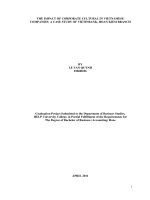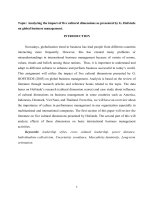the impact of Hofstedes cultural dimensions on global business management.
Bạn đang xem bản rút gọn của tài liệu. Xem và tải ngay bản đầy đủ của tài liệu tại đây (164 KB, 14 trang )
Topic: Analyzing the impact of five cultural dimensions as presented by G. Hofstede
on global business management.
INTRODUCTION
Nowadays, globalization trend in business has lead people from different countries
interacting more frequently. However, this has created many problems or
misunderstandings in international business management because of variety of norms,
values, rituals and beliefs among those nations. Thus, it is important to understand and
adapt to different cultures to enhance and perform business successful in today’s world.
This assignment will utilize the impact of five cultural dimensions presented by G.
HOFSTEDE (2005) on global business management. Analysis is based on the review of
literature through research articles and reference books related to the topic. The data
bases on Hofstede’s research (cultural dimension scores) and case study about influence
of cultural dimensions on business management in some countries such as America,
Indonesia, Denmark, Viet Nam, and Thailand. From this, we will have an overview about
the importance of culture in performance management in any organization especially in
multinational and international companies. The first section of this paper will review the
literature on five cultural dimensions presented by Hofstede. The second part of this will
analyze effects of those dimensions on basic international business management
activities.
Keywords: leadership styles, cross cultural leadership, power distance,
Individualism–collectivism, Uncertainty avoidance, Masculinity–femininity, Long-term
orientation.
1
LITERATURE REVIEW
Geert Hofstede’s dimensional model of national culture has been applied to various
business areas. The Hofstede model (Geert Hofstede & Gert Jan Hofstede 2005)
distinguishes cultures according to five dimensions: power distance,
individualism/collectivism, masculinity/femininity, uncertainty avoidance, and
long-/short-term orientation. The model provides scales from 0 to 100 for 76 countries
for each dimension, and each country has a position on each scale or index which give us
insights into other cultures so that we can manage international business effectively.
There are many studies carried out related to how to manage international business
performance, but very few studies were done on the cultural dimensions impact on global
business management. In this assignment, I will analyze effects of five cultural
dimensions of Hofstede through four main activities associated to global business:
leadership styles, human resources management, motivation assumptions, decision
making and organizational designs and strategies. Although these all dimensions have
contributed in conducting global business management, some highlighted measuring
patterns are mentioned for each activity and some example to prove its effect.
For instance, in leadership styles, decision making process, cooperation, degree of
control and direction, relationship between superior and subordinates will be mentioned
through analyzing Power distance as a main dimension. Problems related to recruitment,
employment, training…will be focused in human resources management part through
theory of long and short term orientation. Strategies, I will focus impact of cross-cultural
management on marketing and negotiation strategies, cross-cultural contexts
(individualism and uncertainty avoidance) are highlighted.
I. Hofstede's cultural dimensions
2
1.1 Power distance
Power distance can be defined as the extent to which the less powerful members of
institutions and organizations within a country expect and accept that power is distributed
unequally. 'Institutions' are the basic elements of society like the family, school, and the
community; 'organizations' are the places where people work. (Geer Hofstede, Gert Jan
Hofstede 2005, p.46).
1.2 Individualism and Collectivism
Individualism pertains to societies in which the ties between individuals are loose:
everyone is expected to look after himself or herself and his or her immediate family.
Collectivism as its opposite pertains to societies in which people from birth onwards are
integrated into strong, cohesive in groups, which throughout people's lifetime continue to
protect them in exchange for unquestioning loyalty (Geer Hofstede, Gert Jan Hofstede
2005, p.76).
1.3 Masculinity and Femininity
Masculinity indicates the extent to which the dominant values of a society are
"masculine" (e.g., assertive and competitive). Masculinity pertains to societies in which
social gender roles are clearly distinct (i.e., men are supposed to be assertive, tough, and
focused on material success whereas women are supposed to be more modest, tender, and
concerned with the quality of life. Femininity pertains to societies in which social gender
roles overlap i.e., both men and women are supposed to be modest, tender, and concerned
with the quality of life. (Geer Hofstede, Gert Jan Hofstede 2005, p.120).
1.4 Uncertainty avoidance
Uncertainty avoidance can be defined as the extent to which the members of a
culture feel threatened by uncertain or unknown situations and try to avoid such
situations. This feeling is, among other things, expressed through nervous stress and in a
need for predictability: a need for written and unwritten rules. (Geer Hofstede, Gert Jan
Hofstede 2005, p.167).
1.5 Long –term orientation (LTO)
Long –term orientation stands for the fostering of virtues oriented towards future
rewards, in particular perseverance and thrift. It’s opposite pole, Short Term Orientation,
stands for the fostering of virtues related to the past and present, in particular, respect for
3
tradition, preservation of ‘face’ and fulfilling social obligations.” (Geer Hofstede, Gert
Jan Hofstede 2005, p.210).
DISCUSSION
I. The impact of five cultural dimensions on global business management
1. Leadership style
In global business world, it is very important to understand the concept of
leadership styles and behavior which are applicable and present in different cultural and
national contexts. This is one of the essential tools to help multinational companies can
understand how and why these cultural factors influence organizational behavior. From
this, they can manage their companies better in different countries. Generally, dimensions
mentioned by Hofstese have been used in various cross cultural leadership style.
According to Dickson, Hartog and Mitchelson (2003) power distance is one of the most
influential cultural dimensions which have been used to have an in-depth analysis of
cross-cultural leadership styles and behaviors in an organization as it deals directly with
the expectations and distribution of power, authority and status. (Sandhiya Goolaup and
Tural Ismayilov 2011, p.40).
Sandhiya Goolaup and Tural Ismayilov 2011, ‘The influence of power distance on
leadership behaviors and styles’. Available from: a-
portal.org/smash/get/diva2:502384/FULLTEXT01.pdf
The leadership styles and behaviors are obviously seen in decision making process,
cooperation, degree of control and direction, organization hierarchy the participation
level of subordinates and setting goals process.
In large-power-distance countries, superiors and subordinates consider each other as
existentially unequal; the hierarchical system is based on this existential inequality.
Organizations centralize power as much as possible in a few hands. Subordinates expect
to be told what to do. There are a lot of supervisory personnel, structured into tall
hierarchical of people reporting to each other. Salary system show wide gaps between top
and bottom in the organization. Superiors are entitled to privileges (literally, “private
4
law”) and contacts between superiors and subordinates are supposed to be initiated by
superiors only (Geer Hofstede, Gert Jan Hofstede 2005, p.55).
Indonesia gets high score of power distance index (78). Indonesian people tend to
be dependent on hierarchy, unequal rights between power holders and non power holders,
superiors in-accessible, leaders are directive, management controls and delegates. Power
is centralized and managers count on the obedience of their team members. Employees
expect to be told what to do. Control is expected and managers are respected for their
position. Communication is indirect and negative feedback hidden. High Power Distance
also means that Indonesian co-workers would expect to be clearly directed by the boss or
manager – it is the classic Guru-Student kind of dynamic that applies to Indonesia
(Hofstede Centre 2011
1
). (Hofstede Centre 2011. Available from: http://geert-
hofstede.com/indonesia.html
In small- power distance countries, subordinates and superiors consider each other
as existentially equal; the hierarchical system is just an inequality of roles, established for
convenience; and roles may be changed, so that someone who today is my subordinates
may tomorrow be my boss. Organizations are fairly decentralized, with flat hierarchical
pyramids and limited numbers of supervisory personnel. Salary ranges between top and
bottom job are relatively small. Superiors should be accessible for subordinates, and the
ideal boss is resourceful (and therefore respected) democrat. Subordinates expect to be
consulted before a decision is made that affects their work, but they accept that the boss
is the one who finally decides (Geer Hofstede, Gert Jan Hofstede 2005, p.56).
Taking Denmark as an example, with a score of 18 points Denmark is at the very
low PDI score compared to other countries. Danes do not lead, they coach and employee
autonomy is required. In fact, Denmark ranks highest amongst the EU27 countries in
terms of employee autonomy. With a very egalitarian mindset the Danes believe in
independency, equal rights, accessible superiors and that management facilitates and
empowers. Power is decentralized and managers count on the experience of their team
members. Respect among the Danes is something which you earn by proving your hands-
on expertise. Workplaces have a very informal atmosphere with direct and involving
communication and on a first name basis. Employees expect to be consulted (Hofstede
Centre 2011
2
). (Hofstede Centre 2011. Available from: http://geert-
hofstede.com/denmark.html)
5
Another example for influence of power distance on behavior, Thailand is described
as a country of high power distance. It’s easy to see the differences in the height of the
‘wai” (the Thai greeting) which represents the extent of this power distance. People who
their status is high will receive a high ‘wai’ meaning finger tips to the nose or even
higher. People who have lower or equal status often receive a lower ‘wai”, finger tips
can be in front of their chest. It’s not in greetings alone, Thai language has specific
honorifics which indicate social standing for each position, sex, age, title or occupation.
The purpose is to save the face of lower status individuals as one need not ask personal
questions of a possibly higher status individual (Eduasiapacific 2012
3
). (Eduasiapacific,
Power Distance and Leadership in Thailand. Available from:
[06/22/2012]
Even though power distance has been one of the most influenced in illustrating the
leadership behaviors and styles in different cultures, the other dimensions provided by
Hofstede have also been considered in cross cultural leadership studies. In relation to the
dimension individualism-collectivism, Jung and Avolio (1999) argued that in
individualistic cultures, supervisors are more prone to adopt a transactional leadership
style whilst collectivist cultures have shown a preference for transformational style. As
they further highlighted, the presence of transformational leadership style within the
collectivist culture has generated more ideas whilst individualist has generated more
ideas with a transactional leader. Similarly, in a study undertaken by Bochner and
Hesketh (1994) in a large, culturally diverse Australian bank they found that persons
from individualistic cultures reported significantly less likelihood of working in a team
rather than alone compared to persons from collectivistic culture. (Sandhiya Goolaup and
Tural Ismayilov 2011, p.41).
Sandhiya Goolaup and Tural Ismayilov 2011, ‘The influence of power distance on
leadership behaviors and styles’. Available from: a-
portal.org/smash/get/diva2:502384/FULLTEXT01.pdf
II. Human recourses management.
The aim of human recourses management is to maximize employee performance in
service of their employer’s strategic objectives. Understanding cross-cultural human
resource management assists to managing the harmonious working relationship between
6
expatriates and local employees. Human resource management including: management
selection, training, evaluation and promotion, and remuneration.
This part will focus the impact of one of cultural dimensions (Short and long –
term orientation) dimension on human recourses management.
For countries with high score of long – term orientation, recruiting or promoting,
managers are selected based on the fit of their personal and educational characteristics, a
prospective employee’s particular skills have less importance in the hiring decision. They
often accept slow results and persist to achieve goals. Training and socialization for a
long term commitment to the organization compensate for any initial weaknesses in
work-related skills (Cullen, K. Praveen 2014).
Cullen, John B. (John Brooks) & Parboteeah, Praveen, (author.)
(2014). Multinational management: a strategic approach (Sixth edition, International
edition / John Cullen, K. Praveen Parboteeah). Australia South-Western
For example, in Viet Nam, employees are hired out of school. For them, selecting a
place to work one of the most important decisions they makes after selecting a spouse
and a university. Vietnamese people like to have a stable job. Thus, when they work in a
company, they have tendency to work in that company for a long time and hardly find
another place to work. Promotions are rather slow, may take most young people from 15
years or more. Employees want to show their loyalty and want to receive a stable job
from that company. Furthermore, performance is very infrequently evaluated, evaluation
base on a long period of time to reduce the probability that luck or misfortune influence
the evaluation. This practice results in linking rewards (such as promotions) to effective
long-term performance. The criteria for promotion are usually a combination of seniority
and merit. Also, educational background plays a role in promotion decisions; a person
who got MBA degree is easy to get promotion than another who has lower educational
background.
The differences in pay increases are very small and rewards are essentially
considered performance of group rather than individual contributions. In addition, they
also care about training for their employees; they can spend money for their employees to
get higher education and give them opportunities to rotate different position in
throughout their working life which helps employees get exposed to many different
businesses.
7
However, for those countries which have short- term orientation especially Western
countries cultures, value logical analysis in their approach to organizational decisions.
They often use quick layoffs of “excess” employees to adjust to shrinking demand for
products (Cullen, K. Praveen 2014).
Taking a case of an American company, they recruit employees from schools, and
they also hire from other companies. High turnover rates among recent MBAs are quite
notorious. Employees often identify more with their profession than with their company,
and job-hopping is not unusual, they expect more rapid advancement, and they can
change the job if they cannot obtain it. Performance of new employees is evaluated soon
after they are recruited. If performance cannot adapt the company's expectations,
employment may be dismissed. The same case happens even for those who have been
with a company for many years and performance is evaluated at least once a year. In
general, the focus of performance appraisal is on short-term results and individual
contributions to the company aims. Difference in pay increases is substantial and often
based on individual contribution. Promotions in U.S. companies are based primarily on
individual performance. Training is often undertaken with hesitation because of the cost
and the concern that the trained person may switch to another company. Thus, employees
are often trained in specialized functions resulting in a rather narrow career path within
the company. In many American companies, employees feel that they may be laid off
especially in economic crisis period.
In the present study, France and Belgium fell above the mean on power distance
with the score 68 and 65, conversely, Germany and United Kingdom scored below the
mean with the score 35 for both. In small power distance countries like Germany and
United Kingdom there is flatter organization pyramids, less power centralization, and
smaller proportion of supervisory personnel, smaller wage differentials and high
qualification of lower strata comparing with the situation in a large power distance
countries such as Belgium and France.
Individualism versus Collectivism Refers to the extent that individuals focus on
individual wants and needs versus the needs of the group. According to this dimension in
individualistic cultures people are supposed to look after only themselves, the ties
between individuals are very loose and Work is important and employees don‟t expect
the company to care of them, whereas in collectivistic cultures people belong to groups
8
that are supposed to look after them in exchange for loyalty and Relationships are
important, the ties between individuals are very tight and employees expect the company
to care of them. Individualistic societies tend to emphasize personal achievement whereas
collectivist cultures highlight group-based achievement. The collectivists rely on other
members in group chronically, they have weaker upwards mobility and underestimate
their contributions they can make for companies, in contrast, the individualists try their
best to do better and better, and finally become the best, they have strong upwards
mobility; at the same time and overestimate the importance of their work in group work.
Erez (2000) indicated that in individualistic cultures the selection procedure of new
employees is based on their personal records, whereas in collectivistic cultures an
important criterion for selecting new employees is recommendations by family members,
who already work for the company.
III. Motivation assumptions
Motivation assumptions are belief regarding how people respond to work.
Cullen and Parboteeah (2008) notes that a great challenge for international
organizations in today’s business world is the ability to retain, attract, and motivate
employees with different cultural backgrounds. When working across cultures an
understanding of needs, goals, values and expectations in different cultures is of great
importance; otherwise what has successfully motivated employees in one culture may be
demotivating and frustrating for employees in another culture. (Phatak, Bhagat &
Kashlak, 2005). For this not to happen, knowledge about what work means to people in
different cultural backgrounds are essential. This knowledge comes from answering two
basic questions: how important is work in people’s lives? And what do people value in
work? (Mikael Nilsson, cited in Cullen & Parboteeah in 2008). Cullen, John B. &
Parboteeah, K. Praveen. (2008). Multinational Management: A Strategic Approach (4th
Ed.). Thomson Higher Education
Effects of Hofstede’s cultural dimensions on motivation assumption
1. Power distance
Organizations in societies with a high power distance are more likely to be highly
hierarchical structured with many levels of management. Work tasks, work design and
reward systems are structured through formal rules and regulations set by the
organization. In contrast, organizational structures in societies low in power distance are
9
more likely to be “flatter” with the absence of formal rules and regulations. Instead,
creativity is encourage and work tasks, work design and reward systems are usually
formulated in consultation between superiors and subordinates. Intrinsic motivation is
often favorably in societies with a low degree of power distance. (Mikael Nilsson, cited
in Phatak etal 2005). Phatak, Arvid V., Bhagat, Rabi S. & Kashlak, Roger J. (2005).
International Management: Managing in a diverse and dynamic global environment. Tata
McGraw-Hill Publishing Company
2. Individualism – Collectivism
Societies with a high degree of individualism are motivated by the opportunities of
individual achievement and increased autonomy than in societies with a high degree of
collectivism, where people are motivated by group achievements, activities and rewards.
Research shows that performance is higher when individualists are working alone than
when working in a group while collectivists working in a group perform higher than
when working alone. (Mikael Nilsson, cited in Phatak etal 2005).
3. Uncertainty Avoidance
The unwilling to take risks, the need for job security and reluctant to make
independent decisions characterize a society high in uncertainty avoidance. It is expected
that decision-making is a task for managers and then provide explicit instructions to the
subordinates, which results in prevented creativity and innovations. In societies low in
uncertainty avoidance is characterized by a desire to perform tasks with calculated risks
as well as continuous problem solving. Societies low in uncertainty avoidance is reflected
by a higher level of achievement motivation, while societies high in uncertainty
avoidance are reflected by strong security motivation. (Mikael Nilsson, cited in Phatak
etal 2005).
4. Masculinity – Femininity
In highly masculine societies, the feeling of competition acts as a motivator. In
contrast, the boundaries between work role and non-work role are more flexible in
feminine societies. This make accommodating work schedules, such as flextime, part-
time, and shift work, as well as jobs that nurture quality of life to act as motivators.
(Mikael Nilsson, cited in Phatak etal 2005).
5. Long-Term versus Short-Term orientation
10
The differences in time orientation that is emphasized in cultures should reflect
compensation schemes and reward systems in order to enhance motivation, job
satisfaction and organizational commitment. (Mikael Nilsson, cited in Phatak etal 2005).
IV. Strategies
1. Negotiation Strategy
In international business, negotiation is an essential condition to help head office
and regional subsidies which have different culture reach an agreement. The dimensions
of culture examined previously are important to properly understand of cultural
background of each country, but also determine which biases may be inherent in them. In
international business, negotiation focuses on the relationship between behavior and
culture.
Culture with high masculinity (assertive and competitive behavior) seek distributive
outcomes and have great difficulty with a synergistic negotiation process. Culture with
high uncertainty avoidance and power distance will be less likely to be comfortable with
a synergistic negotiation process. This impact of culture through the influence of
cognitive bias creates a challenge to negotiation strategy and avoids which seeks a model
that can be predict and obtain integrative outcomes (Paul Drnevich 2004, p 7). (Paul
Drnevich 2004, ‘The role of cultural distance in international negotiation’.Available
from: />One example of cultural differences in business is between the Middle Eastern
countries and the Western countries, especially the United States. When negotiating in
Western countries, the objective is to work toward a target of mutual understanding and
agreement and 'shake-hands' when that agreement is reached – a cultural signal of the end
of negotiations and the start of 'working together'. In Middle Eastern countries much
negotiation takes place leading into the 'agreement', signified by shaking hands.
However, the deal is not complete in the Middle Eastern culture. In fact, it is a cultural
sign that 'serious' negotiations are just beginning. (Vectorstudy, Cultural Dimensions of
Hosftede 2012).
(Vectorstudy, Cultural Dimensions of Hosftede. Available from:
[January 29th,
2012].
11
Another example, the United States scored high at 62 on masculinity index (MAS)
in combination with high individualism (IDV) at 91. Thus, they tend to illustrate their
masculine drive individually which are decisive, assertive, and dominant. They also
consider highly advancement, success and time. In negotiation, Americans are likely to
press ahead with the business and to reach agreement in the shortest time; force weaker
nations to abide by their own deadlines. U.S. negotiators use their own self-defined
deadlines as a means of pressuring the other side to reach agreement, interested not in
building relationships but in achieving results (US Institute of Peace, 2002). (US Institute
of Peace, October 2002, U.S Negotiating Behavior report. Available from:
www.usip.org).
2. Marketing strategy
Cultural distance is probably considered as a well-known term which is presented in
philosophical and psychological specialized (Crane & Hannibal, 2013). However, it also
becomes a vital aspect for doing research of Global Marketing in particular and
International Business Management in general nowadays (Hofstede & Bond, 1998).
Except in human resource, leadership styles, motivation assumption, negotiation
strategies, the five cultural dimensions model is very useful in international marketing
because it affects on consumer behavior to activities related to marketing including:
product, pricing, place and promotion.
In promotion case, one of the first scholars to demonstrate this was Gordon Miracle
(1987). In individualistic cultures, advertising must persuade, whereas in collectivistic
cultures, the purpose is to build relationships and trust between seller and buyer. For
example, Japanese advertising focuses on inducing positive feelings rather than providing
information. The different purposes are reflected in the difference in timing and
frequency of verbal or visual mention of the brand name in television commercials
(Miracle et al. 1992). In a typical Japanese television commercial, the first identification
of a brand, company name, or product occurs later than in a typical US television
commercial. In Chinese commercials, brand acknowledgement appears later than in US
commercials (Zhou et al. 2005).
For example, if you want to market cars in a country where the uncertainty
avoidance is high, you should emphasize on their safety, whereas in other countries you
may base your advertisement on the social image they give you. Cell phone marketing is
12
another interesting example of the application of Hofstede's model for cultural
differences: if you want to advertise cell phones in China, you may show a collective
experience whereas in the United States you may show how an individual uses it to save
time and money. The variety of application of Hofstede's abstract theory is so wide that it
has even been translated in the field of web designing in which you have to adapt to
national preferences according to cultures' values.( Amanpreet Kaur 2013), (Amanpreet
Kaur 2013, "Outsourcing Software Quality", pp. 34-35, Department of Computer and
Information Science report. Available from: Norwegian University of Science and
Technology.
[June 2013].
Taking a case study of IKEA Shanghai Company – a branch of IKEA in China
(IKEA company is known as the world’s most successful mass-market retailer, selling
Scandinavian-style home furnishings and other house goods in 230 stores in 33 countries
and hosting 410 million shoppers per year). This section is devoted to IKEA Shanghai’s
marketing performances from a cultural perspective:
- Product
Chinese New Year is called The Spring Festival in Chinese, which is the most
important festival for the Chinese people. They have habit of decorating their homes
featuring an atmosphere of rejoicing and festivity. At the beginning of 2006, a red rooster
appeared on many IKEA products, greeting the year of the Rooster. This move had won
IKEA many customers. The victory was to be resumed from December 2006, the
products of series FANBY featuring red pigs went home with many Chinese customers
who wanted to bring a new look to their home, welcoming the coming year of the Pig.
The color red has been carefully chosen for the Chinese New Year series because red
suggests good fortune in China and is commonly used in decorations to bring good luck.
It is worth mentioning that the FANBY series are limited editions only available in the
Chinese market. It is reasonable to believe that IKEA will carry on such friendly gestures
to its Chinese customers.
- Promotion
In this part, taking an example related to public relations (PR); is to build good
relations with the company’s various publics by obtaining favorable publicity, building
up a good corporate image, and handling or head off unfavorable rumors, stories, and
13
events. In China, IKEA cooperates with World Wide Fund for Nature (WWF) on forest
projects. The company promises to foster the supply of certified wood products in China
by identifying high conservation value forests in key wood producing regions; educating
and training relevant actors; and promoting legal compliance at all points within domestic
and international supply chains (WWF China). In terms of environmental issues, IKEA
shows its determination of building and maintain a good corporate image in order to
build a long-lasting relationship.
Another marketing activity beginning from the month of preparing and celebrating
Chinese New Year of 2007, was that IKEA Shanghai promised to donate 10 RMB to
UNICEF China for any soft toys sold during that period. Besides another proof of IKEA’s
sense of ethical and social responsibilities, it can be also considered as IKEA’s
understanding of Chinese cultural values in interpersonal relations (Fan 2000)—
reciprocation of greetings, favor and gifts as well as repayment of the good that another
person has caused you. There has not been further report on how many funds IKEA
raised from the activity but for IKEA’s Chinese customers, the company has made a good
gesture.
CONCLUSION
Understanding culture is one of the best ways which helps people solve problems
and reconciles dilemmas. Hofstede's model has proved to be a simple, practical, and
usable tool to the integration of culture into studies. If understood and applied properly,
this information will reduce misunderstanding and frustration among different cultural
countries in business management. But most important, Geert Hofstede will give you the
'edge of understanding' which translates to more successful results and forcing
international business in control.
14









